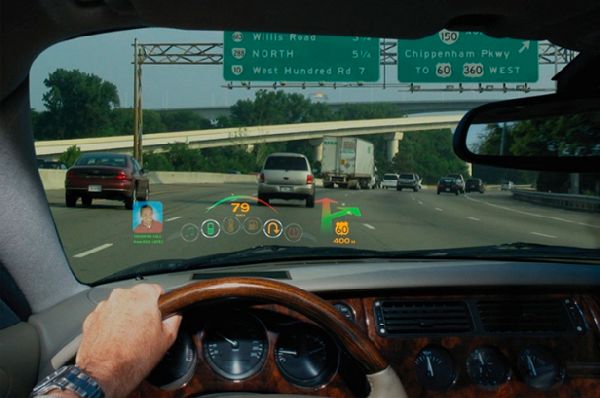Heads-up displays that project information on the windshield in front of the driver, now available on high end models, appear set to become standard fitment in mid-range and even low end cars from 2016. New technology, based on a small laser display engine developed by Microvision, appears set to overcome many of the problems with previous heads-up displays.

Heads-up display for vehicle safety
Several car safety studies have shown that a driver taking his eyes off the road is the primary cause of most accidents. These studies show that the driver needs to keep his eyes on the road for 85 to 90 percent of the time that the car is in motion. The car driver today takes his eyes off the road to look at not just car performance gauges but also other devices such as GPS map information, voice calls and e-mail messages on his phone. For drivers who use reading glasses, this also involves refocusing their eyes frequently between reading these devices and looking back at the road.
A heads-up display that presents this information in the drivers normal field of vision would permit him to continue looking at the road, reducing chances of vehicle accidents.
The laser based display technology from Microvision
Microvision, the Redmond, Washington based technology start-up company has developed a laser based display system that it calls the PicoP (for Pico Projection). The first commercial application of this technology is as an accessory to project images from a smartphone or tablet onto a large screen for use in meeting rooms or at family gatherings. The projector accessory retails for around $350.
The PicoP consists of three laser guns that project red, blue and green light on a 1 mm wide silicon mirror that tilts on two axes. The image to be projected is painted pixel-by- pixel by the light reflected from the mirror. The refresh rate is fast enough to make the images appear stationary.
This laser display overcomes many of the problems the previous LCD based car displays had. One of these has been the visibility of the display in varying light conditions. For the display to be visible in bright sunlight, the light intensity has to be increased. This however causes a distracting glow from the display at night. The LCD projected light also tends to reflect off the windshield glass at certain positions of the driver’s eyes. Laser is polarized light that renders sharper colors than LCDs and the perceived brightness is therefore higher. Laser light also does not reflect off the windshield. The laser image can also be projected as though it is at a 2 to 4 meter distance from the driver’s normal field of vision to make the displays easier to read.
Microvision has licensed Pioneer Corporation of Japan to make an after-market car heads-up display that is expected to be available later this year. Simultaneously, Microvision is working with the Detroit auto majors to build-in these displays into the 2016 model cars.
One possible obstacle for their use in entry level cars could be cost. The auto companies want the system cost to be below $200 and that can be met only if the price of the laser guns go down. Laser gun manufacturers like Nichia, Osram and Soraa are scaling up production but cost breakthroughs will need the kind of volumes that only an automobile OEM application can generate. Perhaps the OEMs can eliminate all conventional dials and gauges and build-in only the heads-up display as standard fitment.
Via: Technologyreview




